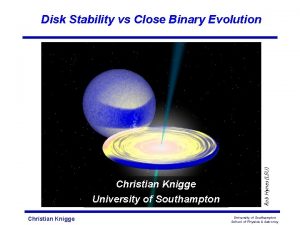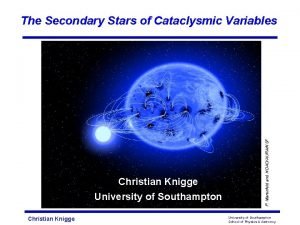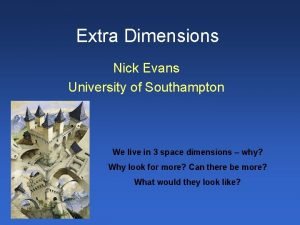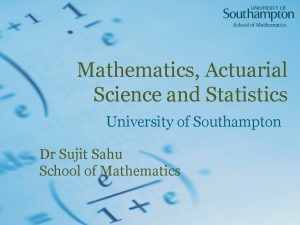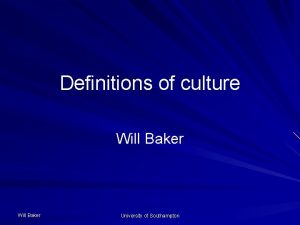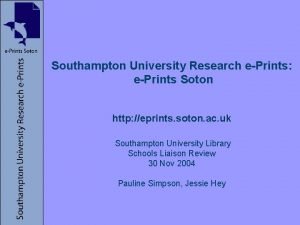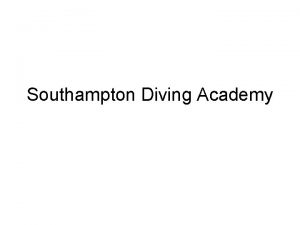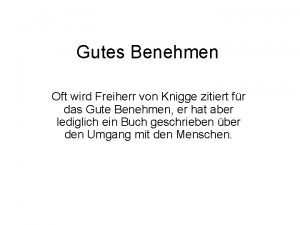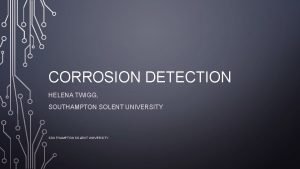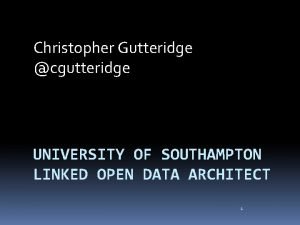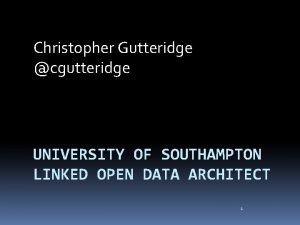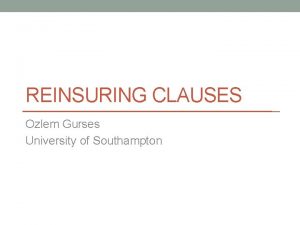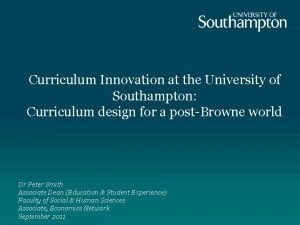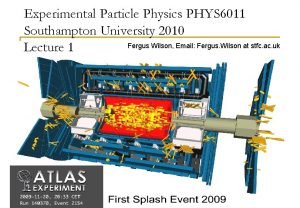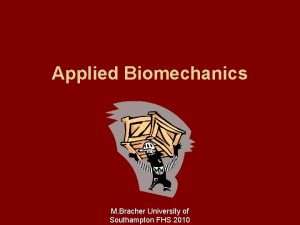Christian Knigge University of Southampton Christian Knigge P



























- Slides: 27

Christian Knigge University of Southampton Christian Knigge P. Marenfeld and NOAO/AURA/NSF The Secondary Stars of Cataclysmic Variables University of Southampton School of Physics & Astronoy

Outline • Introduction – • Part I: The Basic Physics of CV Secondaries – – • • [10%] Magnetic braking A donor-based CV evolution recipe Part III: Substellar Secondaries – – [85%] Theoretical overview Observational overview Part II: Donors and Evolution – – • The evolution of cataclysmic variables: a primer [ 5%] Observed properties Outlook Summary – – What do we know? What do we still need to know? Christian Knigge University of Southampton School of Physics & Astronoy

Cataclysmic Variables: A Primer The Orbital Period Distribution and the Standard Model of CV Evolution Knigge 2006 • Clear “Period Gap” between 2 -3 hrs • Suggests a change in the dominant angular momentum loss mechanism: – Above the gap: • Magnetic Braking • Fast AML ---> High – Below the gap: • Gravitational Radiation • Slow AML ---> Low • Minimum period at Pmin = 76 min – donor transitions from MS -> BD – beyond this, Porb increases again Christian Knigge University of Southampton School of Physics & Astronoy

Part I: The Fundamental Physics of CV Secondaries • The radius of a Roche-lobe filling star depends only on the binary separation and the mass ratio (Paczynski 1971) • The orbital period depends on binary separation and masses (Kepler 1605) • Combining these yields the well-known period-density relation for lobe-filling stars • If we’re allowed to assume that many donors will be low-mass, near-MS stars, we expect roughly • In that case, we have the approximate mass-period and radius-period relation Christian Knigge University of Southampton School of Physics & Astronoy

Should CV donors be on the main sequence? Response to mass loss • We are mainly interested in lower main-sequence stars here, where • The response of such a star to mass loss depends on two time scales – mass-loss time scale: – thermal time scale: • If , the donor remains in thermal equilibrium (and on the MS) despite the mass-loss, we have α≈1 • If , the donor cannot retain thermal equilibrium and instead responds adiabatically; in this case (for the lowest mass stars) α ≈ -⅓ So which is it? Christian Knigge University of Southampton School of Physics & Astronoy

Should CV donors be on the main sequence? Time scales above and below the gap Patterson 1984 • With standard parameters, we find – Thermal – Mass-loss • So we actually have !!! What does that mean for the donor? Christian Knigge University of Southampton School of Physics & Astronoy

Should CV donors be on the main sequence? Almost, but not quite… • When , the donor cannot shrink quite fast enough to keep up with the rate at which mass is removed from the surface • The secondary is therefore driven slightly out of thermal equilibrium, and becomes somewhat oversized for its mass Stehle, Ritter & Kolb 1996 Does any of this actually matter? Yes: this slight difference is key to our understanding of CV evolution! Christian Knigge University of Southampton School of Physics & Astronoy

The importance of being slightly disturbed… Example 1: the period gap • Thought to be due to a sudden reduction of AML at the upper edge (see later) • This reduces • Donor responds by relaxing closer to its equilibrium radius • This causes loss of contact and cessation of mass transfer on a time-scale of • Orbit still continues to shrink (via GR), while donor continues to relax • Ultimately, Roche-lobe catches up and mass-transfer restarts at bottom edge • All of this only works if the donor is significantly bloated above the gap Christian Knigge and increases University of Southampton School of Physics & Astronoy

The importance of being slightly disturbed… Example 1: the period gap • How bloated must the donors be? – Well, if there is no mass-transfer in the gap, • From the period-density relation, we then get • Donor at bottom edge is in or near equilibrium, so… Donor at upper edge must be oversized by ≈30%! Christian Knigge University of Southampton School of Physics & Astronoy

The importance of being slightly disturbed… Example 2: the minimum period • Consider again the period-density relation • Together with a simple power-law M-R relation • Combining the two yields • Differentiating this logarithmically gives • So Pmin occurs when donor is driven so far out of equilibrium that α = ⅓ ! , – Note: isolated brown dwarfs are never in thermal equilibrium and have ≈ -⅓ – Pmin need not coincide with the donor mass reaching the H-burning limit Christian Knigge University of Southampton School of Physics & Astronoy

The importance of being slightly disturbed… Example 3: spectral types • CV donors are mostly/fully convective stars, so Teff is almost independent of luminosity and only depends on mass (Hayashi) – So they don’t follow the MS M-L relation, but instead respect the M-Teff one! – CV donors have the appropiate Teff (and Sp. T) for their mass – Since • they are also overluminous Does this mean the Sp. Ts of CV donors should be the same as those of Roche-lobe filling MS stars at the same Porb ? – NO, because donors are still bloated compared to MS stars of the same mass! – Since same P , donors have lower M 2/Teff and later Sp. Ts than MS stars at Kolb, King & Baraffe 2001 Christian Knigge University of Southampton School of Physics & Astronoy

All theory is grey! Are CV donors observationally distinguishable from MS stars? • Until about decade ago, opinions were split – Patterson (1984), Warner (1995), Smith & Dhillon (1998): • – Echavarria (1983), Friend et al. (1990), Marsh & Dhillon (1995): • • CV donors are indistinguishable as a group from MS stars CV donors have later Sp. Ts than MS stars at the same period Since then, three statistical studies have attempted to clear things up 1. 2. 3. Beuermann et al. (1998) Patterson et al. (2005) Knigge (2006) Christian Knigge University of Southampton School of Physics & Astronoy

Are CV donors observationally distinguishable from MS stars? Spectral Types Beuermann et al. (1998) Podiadlowski, Han & Rappaport (2003) MS Stars CV Donors • CV secondaries above the gap have later Sp. Ts than MS stars at fixed P • Above P = 4 -5 hrs, Sp. Ts show large scatter evolved secondaries? – Yes: Podsiadlowski, Han & Rappaport (2003); Baraffe & Kolb (2000) Christian Knigge University of Southampton School of Physics & Astronoy

Are CV donors observationally distinguishable from MS stars? Spectral Types Knigge (2006) Christian Knigge • Double the number of Sp. Ts (N ≈ 50 N ≈ 100) • B 98 results are confirmed • Donors below the gap also have later Sp. Ts than MS stars at fixed P • Apart from a few systems with evolved secondaries, donors with P < 4 -5 hrs define a remarkably clean evolution track! University of Southampton School of Physics & Astronoy

Are CV donors observationally distinguishable from MS stars? Masses and Radii Patterson et al. (2005), Knigge (2006) M-R relation based on eclipsing and “superhumping” CVs • Donors are significantly larger than MS stars both above and below the gap • Clear discontinuity at M 2 = 0. 20 M☼, separating long- and short-period CVs! – Direct evidence for disrupted angular momentum loss! • Reasonable M-R slopes and gap / bounce masses • Remarkably small scatter (a few percent) Christian Knigge University of Southampton School of Physics & Astronoy

Putting it all together! Constructing a complete, semi-empirical evolution track for CV donors • We have an empirical M-R relation for CV donors… • … and we also expect donors to follow the MS M-Teff relation • Combining these therefore yields a complete stellar parameter sequence – M 2, R 2, L 2, Teff, 2, log g 2 • Combining this sequence with model atmospheres additionally yields – Absolute magnitudes – Spectral Types A complete, semi-empirical donor sequence specifying all physical and photometric properties along the CV evolution track! Christian Knigge University of Southampton School of Physics & Astronoy

A complete, semi-empirical donor sequence (Knigge 2006) Christian Knigge Ask me about implications for donor-based distance estimates! University of Southampton School of Physics & Astronoy

Are spectral types and M-R relation compatible? Knigge (2006) • Christian Knigge Yes: the larger-than-MS donor radii are just right to account for later-than-MS Sp. Ts! University of Southampton School of Physics & Astronoy

Part II: Donors and Evolution Magnetic Braking • All of CV evolution is driven by angular momentum losses • Magnetic braking due to donors is critical in this respect – Basic physics is straightforward • The donor drives a weak wind that co-rotates with donor’s B-field out to the Alfven radius • This spins down the donor and ultimately drains AM from the orbit – Magnetic braking is almost certainly dominant above the gap – It is usually assumed to stop when donor becomes fully convective, but some residual MB may also operate below the gap • Certainly implied by observations of single stars • May help to reconcile CV evolution theory and observations So how well do we understand magnetic braking? Christian Knigge University of Southampton School of Physics & Astronoy

How well do we understand magnetic braking? A compendium of widely used recipes • Verbunt & Zwaan (1981) – • Theoretically motivated; (a=1, n=3/2 Skumanich) Andronov, Pinsonneault & Sills (2003) – • VZ plus ad-hoc power-law in R 2 Kawaler (1988) – • + solid body rotation: Rappaport, Verbunt & Joss (1983) – • Skumanich (1972): Saturated AML prescription based on open cluster data; for CVs Ivanova & Taam (2003) – Another saturated recipe; for CVs Christian Knigge University of Southampton School of Physics & Astronoy

How well do we understand magnetic braking? We don’t! • Orders of magnitude differences between recipes at fixed P • Different recipes do not even agree in basic form! • The saturated ones don’t even beat GR below ~0. 5 M☼ Knigge, Baraffe & Patterson 2009 Christian Knigge University of Southampton School of Physics & Astronoy

Turning the problem around: Can we inferddddd ddfrom the donor M-R relation? • Donors are bloated because they are losing mass • Faster mass loss results in larger donors • So the degree of donor bloating is a measure of a donor’s mass loss rate! • Key advantage: – Donor radius can provide a truly secular (long-term) mass loss rate estimate (averaged over at least a thermal time scale) • Complications: – Degree of bloating actually depends on mass loss history – Tidal deformation, irradiation, activity… might also affect radii Christian Knigge University of Southampton School of Physics & Astronoy

A First Attempt: Constructing a donor-based CV evolution track Knigge, Baraffe & Patterson 2009 Main results • Above the gap, a standard RVJ evolution track works well! • Below the gap, need roughly ≈2 x. GR! • Comparable to recent WD-based results (Townsley & Gänsicke 2009) • May explain larger than expected Pmin (76 min vs 65 min; e. g. Kolb & Baraffe 1999) • May explain larger-thanexpected ratio of long-toshort period CVs (Patterson 1998; Pretorius, Knigge & Kolb 2006, Pretorius & Knigge 2008) Christian Knigge University of Southampton School of Physics & Astronoy

Part III: Substellar Secondaries • Standard model: – 70% of CVs should be period bouncers with substellar secondaries • Until very recently, only a handful of candidates but nothing definite – most famous candidate WZ Sge • Thanks to SDSS, this situation has finally changed – We now have at least 4 deeply eclipsing, short-period CVs with high-quality light curves and accurately measured donor masses below 0. 07 M☼ • • SDSS 1035: SDSS 1433: SDSS 1501: SDSS 1507: Christian Knigge M 2 = 0. 052 M☼ (Littlefair et al. 2006) M 2 = 0. 060 M☼ (Littlefair et al. 2008) M 2 = 0. 053 M☼ (Littlefair et al. 2008) M 2 = 0. 057 M☼ (Littlefair et al. 2007; Patterson et al. 2008) University of Southampton School of Physics & Astronoy

Example: SDSS J 1035 – the prototype! Littlefair et al. 2006 Christian Knigge University of Southampton School of Physics & Astronoy

So substellar donors do exist! What else do we need to know? • If period bouncers dominate the intrinsic CV population, it is vital that we understand their donors – need to know M 2, R 2, L 2, Teff, 2, log g 2, SED • We cannot rely solely on theory to guide us: – structure and atmosphere models of BDs are still very uncertain • No unique M-Teff (BDs cool, so age matters) • presence/absence of atmospheric dust can drastically alter the SEDs – a substellar CV donor may differ drastically from an isolated BD • • It used to be an H-burner until recently It is an exceptionally fast rotators (and thus perhaps abnormally active) It is tidally deformed It suffers strong, time-variable irradiation We have to detect the donors directly! Christian Knigge University of Southampton School of Physics & Astronoy

Summary • The last few years have seen several breakthroughs in our understanding of CV donors and their relation to CV evolution • We now know that – Donors are oversized relative to MS stars of equal mass – As a result, they have later Sp. T than MS stars at fixed Porb – However, they nevertheless follow a MS-based M 2 -Teff relation – Their M-R relation has a discontinuity at M 2 = 0. 2 M☼ disrupted AML – CVs with Porb > 4 -5 hrs mostly contain evolved secondaries – CVs with Porb < 4 -5 hrs follow a remarkably clean and unique evolution track – Substellar secondaries exist! • Key goals for the future in this area must include – A better understanding of MB in single stars, detached binaries and CVs – The direct detection and classification of a substellar secondary Christian Knigge University of Southampton School of Physics & Astronoy
 Christian knigge
Christian knigge Christian knigge
Christian knigge Sei vorsichtig im tadel und
Sei vorsichtig im tadel und Enabling services southampton contact
Enabling services southampton contact Thomas knigge
Thomas knigge Pgr tracker
Pgr tracker Eprints southampton
Eprints southampton Street homeless prevention team southampton
Street homeless prevention team southampton Southampton township school district
Southampton township school district Public health england
Public health england Southampton county, virginia plantations
Southampton county, virginia plantations Sussed soton
Sussed soton Vevox training app
Vevox training app Southampton district energy scheme
Southampton district energy scheme Matt ryan southampton
Matt ryan southampton Dimensions southampton
Dimensions southampton Mike santer
Mike santer Southampton actuarial science
Southampton actuarial science Nick evans southampton
Nick evans southampton Will baker southampton
Will baker southampton Southampton education school
Southampton education school Eprints southampton
Eprints southampton Agresso southampton
Agresso southampton Scc agresso payment
Scc agresso payment Southampton county social services
Southampton county social services Swarthling
Swarthling Gradbook southampton
Gradbook southampton Agresso southampton
Agresso southampton
